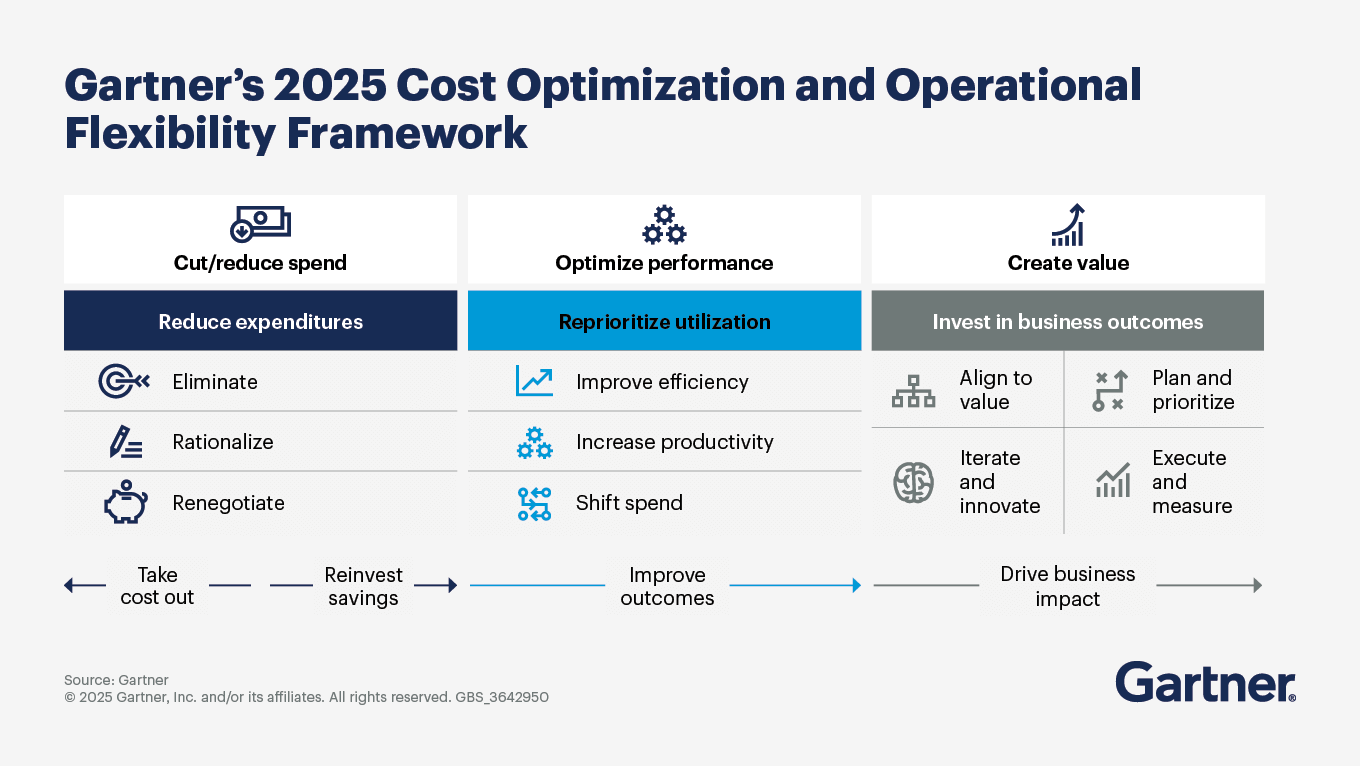Develop a strategic IT cost optimization discipline that maximizes business value while minimizing spend.
- Gartner client? Log in for personalized search results.
Why CIOs must rethink IT cost optimization
In times of economic pressure or transformation, CIOs are often asked to “do more with less.” But cost cutting alone won’t secure long-term success. To truly maximize the value of IT, CIOs must adopt a strategic and programmatic approach to IT cost optimization — one that reduces waste, improves operational performance and reinvests in initiatives that drive business outcomes.
Traditional cost-reduction efforts are reactive, short-term and often disconnected from enterprise priorities. By contrast, strategic IT cost optimization is deliberate, continuous and outcome-driven.
See Gartner research in action at our CIO conferences and events.
3 disciplines of strategic IT cost optimization
For strategic, programmatic IT cost optimization, adopt a disciplined approach to identify and reduce waste, enhance IT performance and reinvest in business outcomes.
IT cost optimization discipline No. 1: Reduce spend
Strategic IT cost optimization starts with identifying areas of excess — from outdated applications to duplicated tools — and reducing spend that no longer contributes to key business outcomes.
The most mature IT organizations review costs continuously, not occasionally. They plan reductions in advance of contract renewals, rationalize spend against evolving priorities and partner across the enterprise to eliminate inefficiencies.
Seek spend reductions by:
Proactively and programmatically reviewing and cutting spend that does not have a demonstrable impact on business outcomes. For example, look for outdated or duplicative technologies.
Eliminating or reducing spend before it is committed by contract. This allows reinvestment of funds in projects that drive increased business value.
Rationalizing all new spend against business priorities — before contacts are signed or renewed.
Renegotiating with vendors and suppliers to improve terms to allow for greater flexibility.
Discover Gartner BuySmart™: Reduce risk and optimize spend on your next tech purchase.
IT cost optimization discipline No. 2: Optimize existing spend for efficiency and effectiveness
Beyond reducing spend, IT cost optimization means helping IT do more with what it already has. This requires CIOs and IT leaders to reallocate resources to IT initiatives with potentially higher impact on business value, by, for example, improving productivity for both IT and the business. The key idea here is to be smarter about spending before committing resources.
Start by assessing where resources are underperforming or misaligned. Use benchmarks to identify outliers in spending patterns and focus IT cost optimization efforts where the gap between cost and value is greatest. This isn’t just about saving money — it’s about shifting spend to improve performance and maximize impact.
Optimize existing spend by:
Improving efficiency: Focus teams on streamlining current processes with fewer resources, often through automation or simplification.
Increasing productivity: Shift talent and tools from low-value tasks to higher-value initiatives that support business growth.
Managing demand: Monitor and eliminate low-usage licenses, technical debt, duplicate tools or shadow IT that drain budgets without driving outcomes.
Reprioritizing resources: Continuously reassess where IT is investing time and money to align spend with what matters most to the business.
Related: Budgeting Guide for U.S. Government Leaders Facing Efficiency Mandates
IT cost optimization discipline No.3: Fund new capabilities
Strategic IT cost optimization doesn’t end with cutting and reallocating — its power also lies in creating space to invest in high-impact initiatives. Leading CIOs use the savings they’ve captured to fund capabilities that reduce enterprise risk, improve operations and unlock growth.
To make intentional and outcome-oriented investments, partner with business leaders to identify which initiatives will deliver the greatest return, build a case for funding and track value over time. This approach elevates IT to a strategic partner.
To fund new capabilities:
Align with business value: Work closely with stakeholders to understand priorities and define success in their terms.
Plan and prioritize: Use formal frameworks to rank initiatives based on their potential business impact, not just urgency or visibility.
Execute and measure: Build a clear investment plan, communicate decisions and measure results against agreed-upon metrics.
Iterate with agility: Continuously evaluate outcomes, adapt to evolving needs and ensure that new investments stay aligned with business goals.
For more on balancing immediate pressures with long-term strategic objectives, fostering a cost-conscious culture and embracing innovation to drive future success, join the complimentary webinar: Executing in a Volatile Economy — Cost Optimization and Operational Flexibility.
Are you a CIO or IT leader at a midsize enterprise?
See how your peers are navigating AI adoption, vendor decisions and evolving business demands — with tools tailored to your role:
Explore our resources for midsize enterprises
Check out a curated list of Gartner’s most popular research being utilized by your peers
Attend a Conference
Experience Chief Information Officer Head of IT conferences
With exclusive insights from Gartner experts on the latest trends, sessions curated for your role and unmatched peer networking, Gartner conferences help you accelerate your priorities.
Gartner IT Infrastructure, Operations & Cloud Strategies Conference
Tokyo, Japan

Drive stronger performance on your mission-critical priorities.
